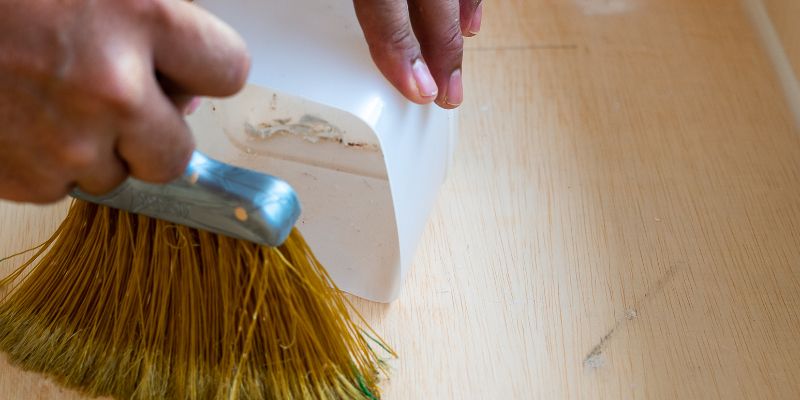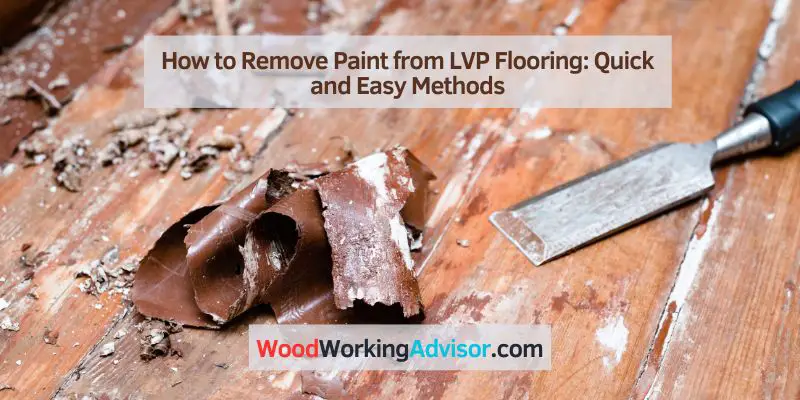To remove paint from LVP flooring, apply a paint remover product and scrub gently with a soft cloth or sponge until the paint is lifted off.
Method 1: Using Paint Remover
If you’ve accidentally spilled paint on your luxury vinyl plank (LVP) flooring, don’t worry! Removing paint from LVP flooring is not as difficult as it may seem. Method 1 involves using a paint remover to effectively get rid of the paint without damaging your flooring. Follow these simple steps to restore the beauty of your LVP flooring.
Step 1: Prepare The Area
Before you begin the paint removal process, it’s essential to prepare the area to ensure a smooth and hassle-free experience. Here’s what you need to do:
- Clear the room of furniture and other obstructions that may hinder your movement.
- Ensure proper ventilation by opening windows or using fans.
- Put on safety goggles, gloves, and a face mask to protect yourself from any fumes or chemicals.
Step 2: Apply The Paint Remover
Once you’ve prepared the area, it’s time to apply the paint remover. Follow these instructions to do it correctly:
- Choose a suitable paint remover specifically designed for use on LVP flooring. Look for a product that is safe to use on your particular flooring type.
- Read the manufacturer’s instructions carefully before applying the paint remover.
- Use a brush or sponge to apply the paint remover directly onto the affected area. Ensure that you cover the paint completely.
Step 3: Let It Sit
Now that you’ve applied the paint remover, it’s time to let it work its magic. Follow these guidelines:
- Allow the paint remover to sit on the paint for the recommended duration mentioned in the product instructions. This will give the remover enough time to loosen the paint.
- Do not rush this process; letting the remover sit for the appropriate time will ensure maximum effectiveness.
- Avoid stepping on the treated area to prevent accidental smearing of the paint remover.
Step 4: Scrub And Remove The Paint
After the paint remover has had enough time to break down the paint, it’s time to scrub and remove the remaining residue:
- Using a soft-bristle brush or sponge, gently scrub the painted area in a circular motion. Apply moderate pressure to ensure thorough cleaning without damaging the flooring.
- Continue scrubbing until all the paint has been lifted from the LVP flooring. Depending on the amount and type of paint, this may take some time.
- If necessary, repeat this step with a fresh layer of paint remover until all the paint has been successfully removed.

Step 5: Clean And Rinse The Floor
Now that you’ve successfully removed the paint, it’s essential to clean and rinse the LVP flooring to restore its original appearance:
- Using a damp cloth or mop, wipe down the entire floor to remove any remaining paint remover or residue.
- Rinse the floor thoroughly with clean water to remove any traces of the paint remover.
- Finally, dry the LVP flooring completely before walking or placing any objects back on it.
By following these steps, you can effectively and safely remove paint from your LVP flooring using a paint remover. Remember to always follow the manufacturer’s instructions and take necessary precautions to protect yourself and your flooring throughout the process.
Method 2: Using Heat Gun
Method 2: Using a heat gun is an effective way to remove paint from Lvp flooring. Simply apply heat to the painted surface and carefully scrape the paint away, revealing clean and pristine flooring underneath.
Using a heat gun can be an effective method to remove paint from LVP (luxury vinyl plank) flooring. This technique utilizes heat to soften the paint, making it easier to scrape off. Follow these steps to safely and efficiently remove paint from your LVP flooring using a heat gun.
Step 1: Prepare The Area
Before you begin, it’s essential to prepare the area to avoid any potential damage or accidents. Here’s what you need to do:
1. Clear the room: Remove any furniture, rugs, or obstacles from the area to create a clear workspace.
2. Ventilate the room: Open windows or use fans to ensure proper ventilation throughout the process.
3. Wear protective gear: Put on safety goggles, gloves, and a mask to protect yourself from any fumes or debris.
Step 2: Heat The Paint
Once the area is prepared, it’s time to heat the paint using a heat gun. Here’s how to do it correctly:
1. Adjust the heat gun settings: Set the heat gun to a low or medium temperature. It’s crucial not to use high heat as it can damage the LVP flooring.
2. Keep a safe distance: Hold the heat gun about 6 to 8 inches away from the painted surface. Maintain a steady motion to evenly distribute the heat.
3. Heat small sections at a time: Work in small sections, heating the paint for approximately 1-2 minutes. Avoid overheating the area to prevent any damage.
Step 3: Scrape Off The Paint
After heating the paint, it should be softened and easier to scrape off. Follow these steps to remove the paint effectively:
1. Use a plastic scraper: Carefully scrape off the softened paint with a plastic scraper. Avoid using metal scrapers as they can scratch the LVP flooring.
2. Work in a gentle motion: Apply light pressure and scrape in the direction of the LVP planks to prevent any damage.
3. Remove any residue: If there are any stubborn paint remnants, you can use a cloth or sponge dampened with warm water to wipe them away.
Step 4: Finish With A Cleaner
To complete the process and ensure any remaining paint is completely removed, finish with a cleaner. Here’s what you need to do:
1. Select an appropriate cleaner: Choose a cleaner specifically designed for LVP flooring. Avoid using harsh chemicals that can damage or discolor the flooring.
2. Follow the manufacturer’s instructions: Dilute the cleaner as instructed and apply it to the affected area. Use a sponge or cloth to gently scrub and remove any residue.
3. Rinse and dry the floor: Once the paint is completely removed, rinse the area with clean water to remove any cleaner residue. Dry the floor thoroughly to prevent slipping and to maintain its integrity.
By following these steps, you can effectively remove paint from your LVP flooring using a heat gun. Remember to always prioritize safety and take necessary precautions throughout the process.
Method 3: Using Vinegar And Baking Soda
Method 3: Using vinegar and baking soda is an effective way to remove paint from LVP flooring. By combining these two household ingredients, you can create a powerful solution that will break down the paint and make it easier to remove without damaging the flooring.
In this method, we will be using a mixture of vinegar and baking soda to tackle those stubborn paint stains on your LVP flooring. Vinegar and baking soda are both effective natural cleaners that can help break down the paint without causing any damage to your floors. Follow these simple steps to remove the paint using this method:
Step 1: Prepare The Mixture
Start by preparing the vinegar and baking soda mixture. In a small bowl or container, combine equal parts vinegar and baking soda. For example, you can use one cup of vinegar and one cup of baking soda. Mix them together until you get a paste-like consistency.
Step 2: Apply The Mixture
Using a clean cloth or sponge, apply the vinegar and baking soda mixture directly onto the paint stains on your LVP flooring. Make sure to cover the entire paint stain with the mixture. Let it sit for about 10-15 minutes. This will give the mixture enough time to penetrate the paint and loosen it from the floor.
Step 3: Scrub And Remove The Paint
Once the mixture has had enough time to work its magic, take a scrub brush or a soft-bristle brush and gently scrub the paint stain in a circular motion. Apply a bit of pressure to remove the paint, but be careful not to scrub too hard as it may damage the LVP flooring. Continue scrubbing until the paint starts to lift off the floor.
Step 4: Clean And Rinse The Floor
After successfully removing the paint, it’s important to clean and rinse the floor to remove any residue. Use a damp cloth or mop to wipe away the leftover vinegar and baking soda mixture from the floor. Make sure to rinse the cloth or mop frequently to avoid spreading the paint residue. Finally, dry the floor thoroughly with a clean towel.

Frequently Asked Questions Of How To Remove Paint From Lvp Flooring
How Do You Remove Dried Paint From Lvp Flooring?
To remove dried paint from LVP flooring, gently scrape away the paint using a plastic scraper or credit card. Then, apply a mixture of warm water and mild soap to the area and scrub with a soft cloth or sponge.
Rinse thoroughly and dry with a soft towel.
Is Paint Thinner Safe On Lvp?
Paint thinner is not safe to use on Luxury Vinyl Plank (LVP) flooring. It can cause damage and discoloration to the surface. It is recommended to use mild soap and water for cleaning LVP floors instead.
Will Acetone Hurt Vinyl Plank Flooring?
No, acetone will not harm vinyl plank flooring.
How Do You Get Paint Off Vinyl Seats?
To remove paint from vinyl seats, gently scrape off the excess paint with a plastic scraper. Then, apply a small amount of rubbing alcohol or nail polish remover on a clean cloth and dab it onto the paint stain. Gently rub in a circular motion until the paint is gone.
Conclusion
To conclude, removing paint from LVP flooring may seem like a daunting task, but with the right tools and techniques, it can be achieved successfully. By following the step-by-step process outlined in this blog post, you can restore the beauty of your LVP flooring without causing any damage.
Remember to always test any cleaning solution on a small, inconspicuous area first, and proceed with caution. With a little patience and effort, your LVP flooring will look as good as new!



5 thoughts on “How to Remove Paint from LVP Flooring: Quick and Easy Methods”